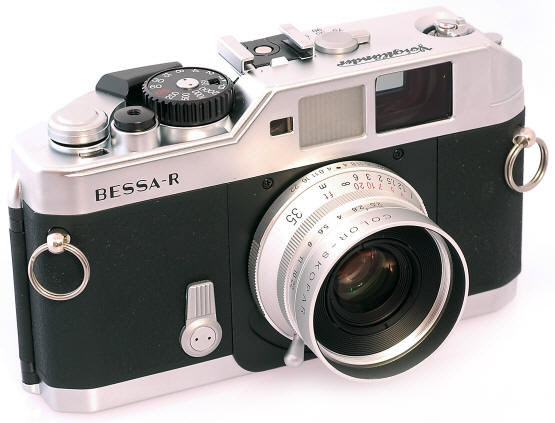
CameraQuest Home Shopping Cart Price List Camera Articles I Buy / Wants Repairs Books Adapters
Shetland Pony wins Kentucky Derby! 1969 Volkswagen Beetle Wins Lemans!
Cosina Makes Viewfinder Bright as Leica M!
Voigtlander Bessa R Rangefinder - When Available Order Here
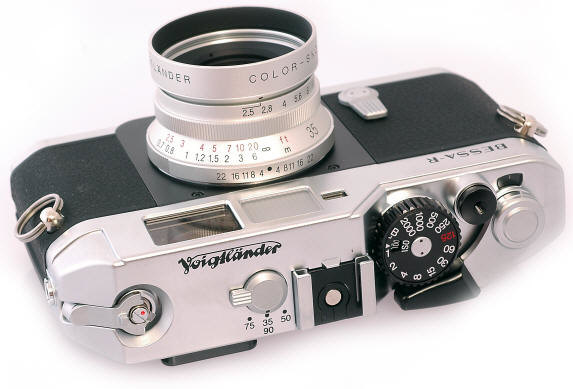
The Cosina made Voigtlander Bessa R is an important event in the history of 35mm Rangefinder cameras --- as strange and seemingly unbelievable as that statement sounds. Ever since its introduction in 1954, the Leica M series has been the undisputed champion of the great Rangefinder/Viewfinder. The M took on the best from Nikon, Canon, Minolta, and everyone else, only to embarrass them with the superb brightness and clarity of the legendary M finder. In 47 years, not one camera could equal the M's bright finder, much less make a brighter finder. Incredibly, the M's ticket in the first seat was challenged in March 2000 by the Cosina made Voigtlander Bessa R, made in Japan. That's right boys and girls, the little Voigtlander Bessa R has a brighter finder than the Leica M3 or M2, believe it or not. The Bessa T was introduced in March 2001. February 2002 saw the introduction of the Bessa R2.
It wasn't supposed to happen this way. IF the Leica finder's brightness was EVER surpassed, surely it could only be by other camera giants like Nikon, Canon, and Zeiss. Alas, oh ye Leica faithful, it was not to be so. An upstart company with no long classic camera tradition, with their FIRST interchangeable lens rangefinder camera, couldn't possibly make a traditional rangefinder camera with a finder this good -- but Cosina did it anyway !
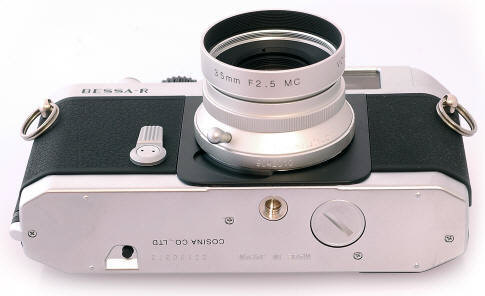
With a GREAT rangefinder/viewfinder, bargain price, and superb lens lineup, it's impossible not to consider the Bessa R THE entry level interchangeable lens 35mm rangefinder. The Bessa R is a great bargain, giving you a lot of Rangefinder camera for the money. These new Voigtlanders are focused on the photogs who want to go out and take pictures. In fact, the Bessa R is a much more convenient shooter than any classic rangefinder without TTL metering. Unfortunately for Leica, it's the camera Leica should have made, but didn't. I wonder how long Leica management will continue to ignore this entry level market, and what effect it will have upon Leica M sales.
If you use ANY classic Leica screw mount camera from whatever manufacturer, the Bessa R makes a great companion body as it offers many features the older designs do not.
Features:
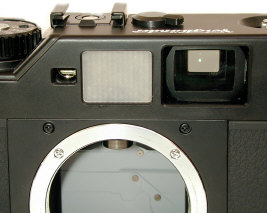

Finder: As stated above, the Bessa R's finder is beautifully done -- the equal of the Leica M in terms of finder and frameline brightness. If you are new to Rangefinders, you might not realize what a big deal this is. It's kind of like Yugo cars coming out of no where, and making a Gran Tourisimo comparable to Ferrari. Conventional wisdom said it couldn't be done -- and no one had done it in almost 50 years of trying !!
- UNLIKE the Leica M finder (either the .72 or .85 version), the outside edges of the widest frame line is easily seen, even if you are wearing glasses. The finder goes well beyond the 35 frameline, supplying an approximation of a 28 finder.
- Like the Leica M, the Bessa R has a VERY bright distortionless finder. Comparing it side to side, I found the Bessa R's finder brighter than recently serviced M3's and M2's, and about the same as my late M6. Framelines for all these cameras were about the same, which is to say very bright.
- The Bessa R's Rangefinder Spot is very bright, much like the M's. Like the M's, the RF spot offers BOTH a split image and super imposed rangefinder image. This means you can focus by bringing together the two images inside the RF spot (super imposed), or by using the split images on the bottom and top of the RF spot (split image). According to an article in Modern Photography many years ago, this dual type of rangefinder focusing can increase focusing accuracy up to 5 times over the less expensive method of having only a superimposed rangefinder image (like the ones used in Leica screw mount cameras, all compact 35mm rangefinders, Canon rangefinders, Nikon rangefinders, and the various Leica copies).
- While I could not get the Bessa R's rangefinder patch to flare out and disappear like sometimes happens with the M6, you do have to be careful and keep your eye centered in the eyepiece. If your eye is too much to the left, you will still see the RF image. If your eye too much to the right, the RF image disappears.
- The R has built in parallax corrected brightline framelines for 35, 50, 75, and 90 lenses. These are manually selected by the three position frameline lever on the top of the camera. The 50 and 75 appear separately, the 35 and 90 are paired together. The finder goes well beyond the boundaries of the 35 frameline, supplying a last resort for at least most of the 28 frameline, if you don't have a separate 28 finder. Likewise, though there is no 135 frameline, it doesn't take much imagination to use the central 2/3 of the 90 frameline for your 135 lens. While the Bessa R's effective rangefinder baselength is too short to consistently and accurately focus 135's wide open and close up, you should have no problems focusing at f/8 and smaller apertures from 15 feet to infinity.
- The Bessa R's finder magnification is .7 -- close to the standard Leica M magnification of .72. Measuring from the edge of the mirror to the center of the viewfinder gives me an approximate baselength of 31mm. 31x.7 = an effective baselength of 21.7 -- or slightly more than the Leica CL's 18.9. I haven't seen any official rangefinder baselength published yet.
- Flash: It seems Voigtlander may have modified the flash circuit going from the Bessa L to the Bessa R, to the effect that some older flashes will not fire on the R -- or so reports one user anyway. This is not so unusual as it might sound. The Leica M6 TTL does the same thing, and requires an adapter for some older flash units.
Body Construction: This is a well made modern camera, with conservative understated styling. Nevertheless, side by side to a Leica M, the Leica's heavier duty and better crafted construction soon becomes obvious. The Bessa R's film advance and shutter are smooth, yet the M's film advance and shutter are almost a religious experience. You have to try them side by side to know what I am talking about. The camera is built on a solid metal die cast frame. The top and bottom plates are a composite material. Personally, I prefer the look of the black R body over the chrome R body. The chrome R body has a "plastic" look to it that the black R body does not.



The R shutter is quieter than the previous Bessa L, though not as quiet as a Leica M. It reminds me of a quiet SLR like the Olympus OM-1. The controls work smoothly and are easy to grasp. The shutter speed dial is large with easy to turn side ribs, rotating 360 degrees, without any stops. The film speed is set by raising and rotating the shutter speed dial. The film speed set is easily visible in the top of the shutter speed dial. The frameline selector is easily seen and chosen. The top and bottom covers are smooth and well done. The front leatherette is easily to grasp and looks handsome, at least to my eyes. While the camera is built on a die cast body, the camera back is reinforced plastic. The right hand side of the back has a built in palm grip which is quite easy and comfortable to grasp. The back door has a film window, to make it a simple thing to know if your camera is loaded or not. As simple as this little feature is, it is dearly appreciated after shooting rangefinder Leicas which have no such luxury. Unlike what I originally feared, the back door is robust and firm, even if it is made of plastic. Open the back by pulling up the rewind lever. With a swing upon back and multi-slot take up spool, loading the Bessa R is quite conventional and very easy. A nice feature are four little pimples at each corner of the bottom plate, to help keep the bottom plate from getting needlessly scratched. Aesthetically I'm in love with the folded Canon P style rewind lever, but it can take several attempts to grip the edge of it and pull it up. On the other hand, if it were too easy to unfold, I would be complaining about it.
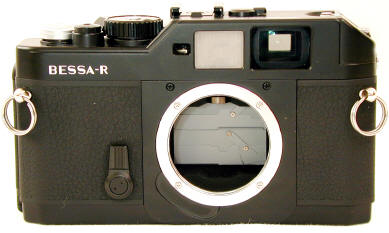
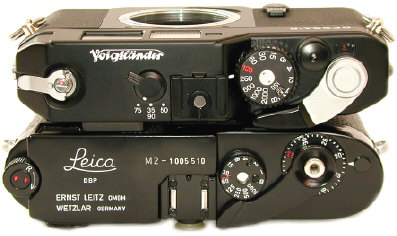

Size and Weight: An unloaded Bessa R weighs in at 14 oz, an unloaded M2 body weighs in at 20 1/2 oz -- a difference of 6 1/2 oz. In practical terms the Bessa R and the Leica M are the close to the same size, with just a few millimeter differences here and there. Nevertheless, the Bessa R FEELS like a much smaller camera in my hands than the Leica M due to the lighter weight. I was surprised to find only a 6.5 oz weight difference -- subjectively it felt like a lot more. The official measurements are a weight of 395 grams, measuring 135.5 X 78.5 X 33.5 MM.
Shutter: Like the Bessa L, the Bessa R has a modified mechanical Copal shutter with speeds from 1 to 1/2000 pus B, and a flash sync at 1/125th. The vertically traveling blades are metal. Unlike standard SLR Copal shutters, the Bessa Copal has TWO sets of shutter curtains to make sure the camera stays light tight. That's right, it's like two shutters being built parallel to each other. Without the dual shutters, there would be light leak problems -- like the Yasuhara has by using a standard Copal shutter. SLR shutters spend 99.99999% of their time in the dark with the mirror down -- so SLR shutters don't have to be as light tight as the Rangefinder shutters. The best way to see both shutters is trip the self timer with the lens removed. The gray outer shutter goes up at the release of the self timer, showing the black main shutter behind it.
Flash: Both a hot shoe and PC connections are provided. The PC connection is thankfully at the end of the camera, where it won't poke you in the eye like the Leica M. TTL or dedicated flash is not provided.
Meter: The Silicon metering cell at the bottom of the film chamber takes a centerweighted reflected meter reading off the gray painted outer shutter curtain. Film speed range 25 to 3200. The meter is activated by slightly pressing the shutter release, and stays on for about 10 seconds after pressure on the shutter is released, even after the shutter is pressed. The bottom center of the viewfinder has large, very easy to see LEDs. The center is a red circle. To the right or left of it you have arrows with a plus and minus inside of them, indicating under or over exposure. The direction of the arrows show you which way to turn the aperture ring. The meter is VERY easy to see, even with glasses. Personally, I prefer this larger size meter display over either the M6 Classic or the M6 TTL. The meter is powered by a two standard size and very easy to get LR44 or SR44 batteries. Dead batteries will kill the meter, but not the mechanical shutter. The shot on the right is taken from the back of the camera with the shutter open, showing the silicon metering cell angled towards the outer shutter. As long as the LED's light when you lightly press the shutter release, the batteries are good.
Bessa R Metering Pattern
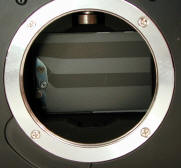
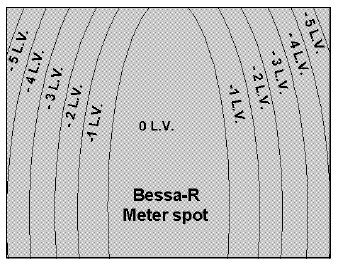
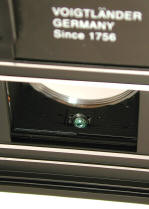
The only only info I have seen from Cosina on the Bessa R's metering pattern describes it as "centerweighted." Dutch fiber optic engineer Frans de Gruijter decided to test out his Bessa R metering pattern. The result is the pattern shown to the left, copyright Frans de Gruijter 2003, all rights reserved. It is interesting to me that the R meter weights the entire center of the picture from top to bottom, with emphasis on the lower portion (since statistically most pics are horizontal and too much sky will throw off your meter reading). This info can be important to you in some metering situations. Many Thanks Frans!
The "Voigtlander Germany Since 1756" engraving on the back of the top plate may surprise some photogs. The old Voigtlander died in the late 1970's, murdered by a Zeiss buyout. Zeiss didn't even keep the rights to the Voigtlander name. Eventually the Voigtlander name came to be owned by Ringphoto in Germany. This Cosina made Voigtlander has nothing to do with the original German firm, other than licensing the use of the name. While some will complain about the Voigtlander name being "used" like this by another company, I believe Cosina is trying to pay homage to Voigtlander's great classic camera tradition. The new "Voigtlander" is keeping the old name alive in a new market, with a new camera with classic camera values. Don't forget this is the first Voigtlander camera that a new generation of photogs could ever buy NEW --- is that really something to complain about ?
Although the Bessa R uses a standard Leica screw mount, this does not mean all lenses are 100% compatible. I received an email from someone who found out the hard way that collapsing a 50/3.5 Elmar into the Bessa R body will result in a metallic screeching sound that you don't want to hear. If the lens is collapsible, be careful and test it out before collapsing the lens all the way into the body.
In service the Bessa R has proven relatively reliable. The thing that gives the most trouble is the rangefinder alignment. Thankfully, it is an easy adjustment. Before you start running for Leica, remember that in the past five years the Leica M6 has had more than its share of troubles too: plastic film counter gears that would break too easily, a small run of M6 which passed quality control with film plates that would scratch film, and many M6 TTL which eat batteries like candy. No, the Bessa R is not as rugged as a Leica M6, but you would have to be a fool to expect a $400 camera to be the mechanical equal of a camera selling for $2000. The new Voigtlander Bessa R and T are made to give the buyer the most rangefinder camera at the lowest possible price, and they succeed admirably.
Leica's last Leica regular production screw mount camera was discontinued in 1960 -- the IIIg. Now only four decades later, Voigtlander will probably have a best seller using this "obsolete" mount. Hmmm....maybe Leica gave up on venerable screw mount a bit too soon. Leica had only introduced the classic 39mm screw mount in 1931 on the Leica Standard. I wonder how long it will take for the 42mm Pentax screw mount to be re-introduced.
With all of this Bessa R envy, the logical question is "How Does the Bessa R compare to the Leica M6?" That's easy, it doesn't. They were designed for different tasks, for different markets. The M6 is the top of the line camera, the better made camera, with the best lenses, with the highest price tag. The Bessa R occupies the entry level market, giving the photog the most bang for their buck, also with a large lens lineup of superb lenses. In my estimation, each camera fills its niche in the marketing system extraordinarily well.
Funny Bessa R Story: I know two Leica M photogs with complete expensive M outfits that bought Bessa R outfits. Why ? Amazingly, both photogs said the same thing: Their Leica M outfits are sooooo expensive, they worry about getting their M outfits stolen on location. So both photogs (and probably many more) are leaving their expensive M's safe at home and using the Bessa R to take pictures. hmm.... it looks like Leica's single tier elitist pricing structure might have backfired. For the price of one APO M lens, you can get an entire Bessa R outfit.
Bessa R Variations:
Early R's often had Rangefinder alignment problems right out of the box. In August 2000, five months after its introduction, there are more and more reports with problems of the R's horizontal RF alignment. Most reports were of the two RF images not over lapping as they should at infinity. To that point in time I had encountered only one such problem with bodies imported from Japan, but MANY reports have surfaced of officially US imported R bodies through the the first US importer, THK. I couldn't help wondering if the sea container was dropped on the dock. While they simply needed an adjustment of the RF to set things right, it was still not expected for a new camera.
Some people have complained to me they had to look at up to five R bodies in the stores before getting one with correct RF alignment. New to Rangefinders ? With a lens mounted and focused on a object a couple of blocks away, the bright RF patch image should align perfectly Vertically and Horizontally. The Horizontal image is responsible for the focusing of lens. The Vertical alignment is just for ease of use and less eyestrain. In other words, the camera should still focus accurately with only the Vertical alignment off. Adjusting the R's rangefinder is not particularly hard, and if you search the net you will find instructions for the do-it-your-selfers. I don't post them here, because if anyone screws up, I don't want an email claiming I owe them a camera.
One camera repairman believed that the RF adjustments, located just beneath the accessory shoe, are too close to the shoe. He theorized that rough handling of the body when attaching or removing a flash might tweak it just enough to knock the RF out of adjustment. It might be best to attach and remove any finder or flash carefully in the Bessa R accessory shoe.
Nevertheless, customers should not put up with any problems in a new camera. No doubt as time goes on these RF problems will be taken care of, but for now it can cause a lot of frustration.
The happy part of this story is that as time went on, fewer and fewer new R's have rangefinder alignment problems right out of the box. If you are a rangefinder newbie, don't over react. Even the expensive Leica M rangefinders go out of adjustment from time to time. If you shoot rangefinders, you expect sooner or later to have the RF adjusted.
ALL of the new Bessas share the same Copal shutter, with an outer light shield. BE CAREFUL not to advance the film while the shutter is still open from the previous exposure when you get in a hurry, or on slow shutter speeds. This is the cause of 99% of the jammed shutters I have encountered.
In practical terms, the Bessa R is an updated version of the Leica CL: Compared to the CL, the R is still an entry level rangefinder camera with short effective rangefinder baselength, but with a greatly improved rangefinder and viewfinder, better metering and meter finder readout, better handling, more framelines, and easier film loading. Hmm....not a bad heritage at all. Like I said before, it's really too bad Leica did not make this camera. The 35mm Rangefinder Renaissance is under way, and in good hands.
Voigtlander Bessa R 1sts:
The first System 35mm Rangefinder EVER introduced which was not either made by the big four (Leica, Zeiss, Nikon, Canon), or a copy of a big four product. System 35 Rangefinder is defined here as a coupled rangefinder camera with a large quality lens lineup.
The Bessa R is the first regular production LTM Rangefinder camera ever with TTL metering. Yes, I know about the Yasuhara, but the very limited production and shutter design defect do not qualify it as a regular production camera, in my opinion.
The first quality Leica Screw Mount 35mm Rangefinder made in three decades -- since the death of the Canon 7s.
Introduced in 1931 on the Leica Standard, the 39mm Leica Screw Mount (known to the politically correct crowd as LTM or Leica Thread Mount) was the 1st standardized lens mount for 35mm cameras. With the Bessa L and R, it establishes a record as the oldest 35mm mount still being manufactured.
The Voigtlander Bessa R is an impressive achievement. Cosina and Cosina's CEO, Mr. Kobayashi, are to be congratulated.
Mr. Kobayashi is proving amazing things can be done when a classic camera lover is in the man in charge at the camera factory.
My thanks to Ken Iisaka, Tom Abrahamsson, and Hiroshi Kohsaka for early details of the Bessa R.
Bessa R Conquers Antarctic
Ron Naveen bought a new Voigtlander Bessa R the day before he left for the Antarctic. I wondered how he and the camera would do, living out in real life one of those National Geographic stories that I would only read about. I received this email about their exploits:
Stephen -
My long Antarctic season is, finally, over. But no complaints. Lots of success with my censusing and other work.
Wanted to tell you that the Bessa-R and f2.5 35mm did rather well,
indeed (see attached Weddell seal photo), surviving quite well through ambient temps of -3C to +4C and wind chills as low as -8 to -10C. Probably the furthest south the R has thus far been. Quite useful for lots of the photo documentation that our Inventory generates. Take care of her and she survives nicely.Soon,
Ron (Naveen)
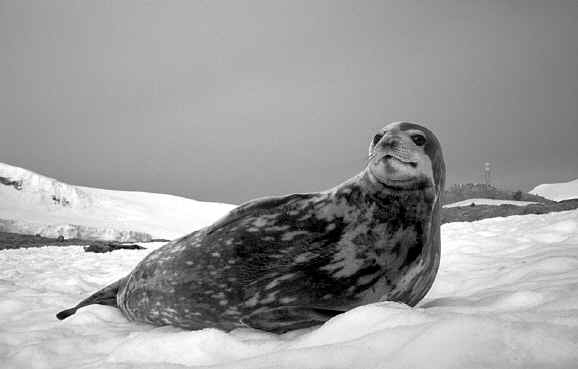
Prices Voigtlander System Bessa Chart Bessa R2A/R3A Bessa R2 Bessa T Heliar 101 101 PICS Bessa T intro Bessa T T or IIIf? Bessa R Lenses 35/1.2 21/25 Shade
Accessories VC Meter II MiniSoftRelease Bessa R2S & R2C SC Lens Intro SC Lenses SL Lenses SL 12&15 Lenses Prominent 50mm Lens Adapter
CameraQuest Home Shopping Cart Price List Camera Articles I Buy / Wants Repairs Books Adapters
Revised: September 11, 2017 . Copyright � 2002-13 Stephen Gandy. All rights reserved. This means you may NOT copy and re-use the text or the pictures in ANY other internet or printed publication of ANY kind. Information in this document is subject to change without notice. Other products and companies referred to herein are trademarks or registered trademarks of their respective companies or mark holders.